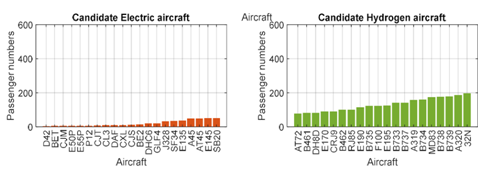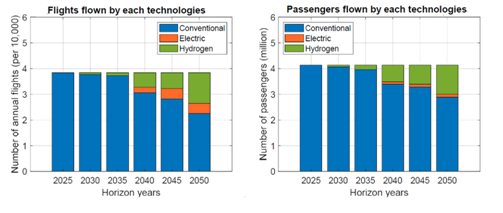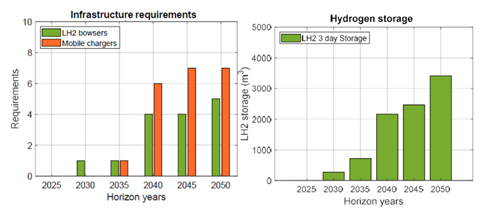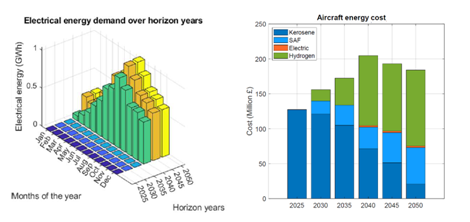Airport Infrastructure Readiness to Power Zero Emissions Flight
Written by Chung Fong, Mazheruddin Syed, Iain R. G. Fleming, Graeme Burt, Efstathios (Stathis) Tapinos, Pavlina Van Rooyenova, Kirsty Webster, and Jon Matthews
The aviation industry has recently reaffirmed its commitment to achieving net zero emissions by 2050. Battery technology holds the potential to power regional aircraft while hydrogen has the potential to power up to narrow-body aircraft. Green SAF (Sustainable Aviation Fuel) could potentially cater for all existing aircraft classes1. All three energy sources have associated net emission profiles, costs, and technological challenges. Although noteworthy progress is being made toward the net zero flight ambition, emissions targets will only be realised with the active commitment and support of airport operators. Existing airports are not designed for electrified or hydrogen aircraft operations and as such development and deployment of new infrastructure will be required.
Battery-based aircraft will require additional electrical supply (or reinforcement of existing supplies), battery storage facilities, and charging infrastructure. Fixed and mobile battery charger technologies will play a key role in the adoption of battery-based flights with minimal disruption to current levels of flight schedules. Hydrogen aircraft will require electrical infrastructure upgrades, depending on the generation and storage model adopted. The liquefaction and/or electrolysis of green hydrogen at airports will require 100s of MW or GW2 levels of power for large airports, as well as large geographical areas, posing a significant challenge to existing airports. This will inevitability be traded-off against offsite production and cost-effectiveness of mass transport of hydrogen to the airport. SAF on the other hand most likely will make use of infrastructure similar to existing airport kerosene infrastructure, however, challenges still exist for the cost of production at scale and lifecycle balance of net zero emissions.
The uncertainty over the combination and pace of net zero technologies that will be adopted will need to be resolved for adequate planning at the airports. The associated requirements for infrastructure will furthermore be airport specific, based on scale and fleet profiles. For example, a small airport on a remote UK island may mostly see smaller regional-sized aircraft as the bulk of its fleet, with limited grid connection. As such, the application of an all-battery aircraft fleet supported by local distributed generation may be the preferred pathway in such a scenario. On the other hand, a large international UK city airport may have a large narrow body fleet more suited to hydrogen. The requirement in such a case may be to transport hydrogen to the airport at scale with the electrical infrastructure supporting cryogenic storage and handling of liquid hydrogen on- site. It is also important to note that airports do not exist as standalone entities: the interconnecting routes, macro trends of technology, industry standardisation, and at-scale economic viability will influence the mode of de-carbonised flight adopted along with government policies and incentives. By beginning to explore such influences, capturing the various transition pathways and trade-offs: decision makers can be provided with information for better planning.
A comprehensive methodology (further updated from with hydrogen representation)3 has been developed at the University of Strathclyde with AGS Airports Ltd to address this very problem. The methodology involves developing perceived representative alternative futures for sustainable aviation that are likely to unfold subject to key drivers aligned to the airport fleet profiles and macro technology projections.
The airside energy demand methodology evaluates the energy profiles over five-year increments using existing airport fleet and journey data to derive equivalent energy needs. Assigning decarbonization technology based on aircraft classes, technology viability curves throughout the horizon years indicate the point in which replacement, additions, or retrofit of different aircraft classes are possible. The projection of energy profiling and transition points allows for assessment of the resultant emission (CO2, NOx, and water vapor), and necessary onsite upgrades to handle electrical power and hydrogen volume increases (such as chargers, hydrogen tanks, and bowsers). Energy costs, time, and seasonal-based variations in energy usage and aircraft schedule deviations are also revealed. This allows the planner to determine more favorable pathways to adopt and the infrastructure decision milestones moving forward. The methodology also captures more detailed aspects, such as energy cost fluctuations over time, aircraft hydrogen tank design projections, improvement to airframe aerodynamics and engine design over time, changing aircraft loading factors, and travel demand over time as well as SAF blends to allow for a more comprehensive representation.
The following are example results (Figure 1-4) for a generalized large UK airport case study using the methodology to showcase the type of information that can be provided to the airport operator for future planning. In particular, Figure 1 shows the pre-assignment of different aircraft classes (ICAO aircraft code4) to decarbonization technology in the methodology. This is sorted by maximum passenger capacity in ascending order (based on various published sources for each aircraft class including manufacturer data). The transition pathway used defines the allocation threshold.
Figure 1: Assignment of technology to different aircraft class (a) battery, (b) Hydrogen.
Figure 2: Projected adoption of decarbonization technology (conventional includes conventional Kerosene or SAF). (a) quantified as flights, (b) quantified as passengers.
Figure 3: Upgrades to airport required (a) charging and refueling assets (1MW per mobile charger and 4 ton per bowser), (b) Hydrogen storage volume.
Figure 4: a) seasonal variation in electrical demand for fleet electrification (not including airport baseline energy demand), (b) energy costs.
In conclusion, it is important for airports to plan for flight decarbonization to support the realization of ambitious targets at pace. Through methodologies like the one presented, airport operators can comprehend the pace and balance of energy, as well as support infrastructure changes required at the airport in line with likely transition pathways. This will help with the future microgrid /energy hub transformation of the airport through the identification of distribution points, evolving demands including EVs, and seasonal variations in travel in line with distributed/renewables generation. Airports will not only serve as major connectors of people and goods but have the chance to become major connectors of greener energy resources and transport energy demands of the future.
References
- Air Transport Action Group. (2021). Waypoint 2050. Second edition
- Airbus, Groupe ADP, Air Liquide. (2022). How to make your airport hydrogen ready?. Presentation presented at Towards Sustainable Aviation Summit 2022, 3AF, Toulouse, France.
- Fleming, I. R. G., Chikumbanje, M., Fong, C. M., Syed, M. H., Burt, G., & Webster, K. (2022). Airport infrastructure planning to support sustainable aviation. Paper presented at Towards Sustainable Aviation Summit 2022, 3AF, Toulouse, France.
- Aircraft Type Designators, www.icao.int. https://www.icao.int/publications/doc8643/pages/search.aspx.
This article was edited by Julio Usaola.
To view all articles in this issue, please go to February 2023 eBulletin. For a downloadable copy, please visit the IEEE Smart Grid Resource Center.

Chung Fong is a Research Associate working within the Aerospace Electrical Systems team at the University. He received his MEng degree in electrical and mechanical engineering from the University of Strathclyde in 2008 and subsequently, his engineering doctorate in the area of aero-electrical systems in 2016. His current research is in multi-criteria aircraft electrical system design, including reliability and availability evaluation for Hybrid Electric Propulsion, eVTOL and More Electric Aircraft. Additionally, he also has research interest in airport infrastructure decarbonisation and hydrogen.

Mazheruddin Syed received his BE degree in Electrical and Electronics Engineering from Osmania University, India, in 2011, MSc degree in Electrical Power Engineering from Masdar Institute of Science and Technology, UAE, in 2013 and Ph.D. degree in Electronic and Electrical Engineering from the University of Strathclyde, Scotland in 2018. He is currently a Strathclyde Chancellor's Fellow (Lecturer) with the Institute for Energy and Environment in the Department of Electronic and Electrical Engineering at the University of Strathclyde. He also serves as the manager for the Dynamic Power Systems Laboratory at Strathclyde. He leads the International Energy Agency (IEA) ISGAN SIRFN Advanced Laboratory Testing Methods Task and is the Secretary of IEEE Task Force on Control of Distributed Resources in Energy Internet. His research interests include demand side management, decentralized and distributed control, real-time controller and power hardware in the loop simulations, geographically distributed simulations, and systems-level validations.

Iain R. G. Fleming received his MEng (Hons) degree in electrical and mechanical engineering from the University of Strathclyde, Glasgow, UK. He is currently a Ph.D. student at the Rolls-Royce University Technology Centre for Electrical Power Systems at the University of Strathclyde, Glasgow, UK, and a research assistant within the Institute for Energy and Environment at Strathclyde. His research interests include the design and modeling of convectional and future zero-carbon propulsion technologies.
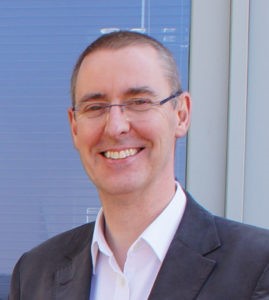
Graeme Burt is a Distinguished Professor of electrical power systems and Director of the Institute for Energy and Environment within the Department of Electronic and Electrical Engineering at the University of Strathclyde. He is lead academic for PNDC, an industrialisation centre focused on accelerating integrated energy solutions and de-risking power technologies. Prof. Burt also directs the Rolls-Royce University Technology Centre in electrical power systems. He is part of the leadership team of ISCF DER Centre Scotland, a regional centre supporting supply chain growth for power electronics, machines, and drives for high power and high integrity systems. His research interests include the areas of decentralised energy and smart grid protection and control; electrification of aerospace and marine propulsion; DC and hybrid power distribution; and experimental systems testing and validation with power hardware in the loop. He furthermore serves as a board member of the National Aerospace Research Consortium (UK-ARC), the International Association of Distributed Energy Laboratories (DERlab e.V.), and the Hydrogen Accelerator (H2A).
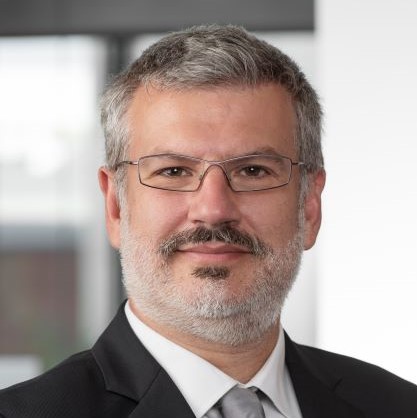
Efstathios (Stathis) Tapinos is the Associate Dean for Knowledge Exchange at Strathclyde Business School and a Senior Lecturer at the Hunter Centre for Entrepreneurship at the University of Strathclyde. He holds a Ph.D. from Warwick Business School. He was previously a visiting research fellow at Said Business School. His research field is Strategy Process and Practice, and he specialises in the impact of uncertainty on strategy, and how managers try to make sense of it with foresight and strategy tools. Stathis has extensive experience in the application of scenario planning, having taught and facilitated relevant workshops with different organisations.

Pavlina Van Rooyenova is a doctoral researcher at Hunter Centre of Entrepreneurship at Strathclyde Business School. She has a bachelor’s degree in business studies. Her master’s degree is in Entrepreneurial leadership and management. In addition to her genuine interest in strategic management research, Pavlina has previous experience as a business owner with a keen interest in business development and an entrepreneurial mindset. Pavlina’s main interest is in the area of individual behaviour in scenario planning processes and its impact on future-thinking development during foresight workshops. Her current research is focused on explaining the theoretical structure and mechanism underlying scenario planning process based on the philosophical views of critical realism and application of structuration theory.

Kirsty Webster has a bachelor’s degree in environmental chemistry and geography from the University of Glasgow. She was appointed regional environmental manager during her time at Sir Robert McAlpine, a building and civil engineering company prior to 2018. She is currently the Sustainability Assurance Manager at Glasgow Airport Limited.

Jon Matthews, Group Head of Capital and Planning, AGS Airports Ltd, is the lead contact for Glasgow Airport. Jon delivers financial and management accounting, assurance, and risk management for national and international businesses across the Energy and Aviation industries, with budgetary control spanning hundreds of millions of pounds. He also developed and implemented long-term strategies for commercial and property functions - maximising income, minimising costs, and optimising the customer service proposition. Jon manages large-scale capital projects, including partnering with key stakeholders across the private and public sectors to deliver regional and national infrastructure. He leads an innovation team to redesign the future state of a complex multi-airport operation, with a particular focus on digitalisation, automation, and sustainability, including the development of a 16mW Solar Farm at Glasgow Airport.
To have the Bulletin delivered monthly to your inbox, join the IEEE Smart Grid Community.
Past Issues
To view archived articles, and issues, which deliver rich insight into the forces shaping the future of the smart grid. Older Bulletins (formerly eNewsletter) can be found here. To download full issues, visit the publications section of the IEEE Smart Grid Resource Center.


